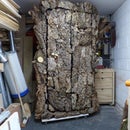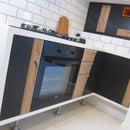Introduction: Concrete Dodecahedron Speaker
So after taking a bit of inspiration from the "A Dodecahedron Speaker for Desktop Printers" project by 60cyclehum I decide to have a go at building my own dodecahedron speaker.
I don't own a 3D printer so using an online service to print 12x the parts would have been very expensive. Because of the modular nature of this design I saw a way to greatly reduce the cost by instead 3D printing a mold and using that to cast the 12 faces. In this case I used concrete because its cheap and would give the speaker a unique look.
The finished speaker measures ~150mm across and weighs ~1.75kg
The .stl's for the mold I designed are attached: Its designed around the speaker dimensions shown but you should be able to scale that model up to fit different speaker diameters..
If you're like me and don't have your own 3D printer I would recommend using the services of 3DPRINTUK
Stuff you'll need:
Parts:
- 3d printed mold
- 5pcs x M4x20mm bolts and wing nuts
- 12pcs x Speakers - The ones I've used are 4 ohm, 5W & 57mm diameter - Monacor SP 6/4
- Main Speaker cable - the one that will connect the speaker to your source
- Speaker cable to wire the 12 speakers together - I got a 50m reel of 2x13 strand for £6 (more than enough!! maybe a 2nd speaker??)
- Rope - length depends on what you want to hang it from..
- Wood offcuts & 0.8mm plywood sheet
Consumables:
- Primer and gloss spray paint - any colour will do
- Concrete - I went for rapid set to speed up production, I got a 10kg bag which was more than enough
- Grab adhesive - Something like "Evo Stik Sticks Like Sh*t" - made sure what you use can bond to two impervious materials..
- Mold release (hair wax)
- Solder
- Heat shrink / electrical tape
Tools/Equipment:
- Sandpaper
- Mixing Bucket etc
- Sealant Gun
- Wire cutters/strippers/knife
- Soldering Iron
- Lighter (poor man's heat gun...)
- Multimeter
- Screwdrivers
- Drill + bits
Step 1: Designing the Mold
I've included links to the files I created but if you have experience with CAD and want to have a go at designing your own mold here are the main steps I took...
- To start, you want to design what the final part will look like, what will come out the mold. Each face is essentially a pentagon with a 31.72deg mitre. I used features like revolve, surface/body cuts and fillets to create a shape I was happy with. The final form will ultimately come down to you and your speaker choice... The important thing to consider at this stage is that this will have to be removed from the mold so think about where the splitline will be and avoid overhangs in the direction the cast will remove from. Adding slight drafts to vertical faces will also make it easier to remove..
- Once you have a design your happy with, use the shell tool. Select an outward shell with a wall thickness of at least 1.5mm, with the bottom face selected as the one to remove.
- You should now have a negative of your original shape - the start of the mold. It should currently be one body so you'll need to split it into two bodies, in a plane that allows the mold to be pulled apart and the cast removed. If you don't have much experience of designing for molding you might want to do a Google search for tips - I design parts for injection molding everyday at work which helps..
- Next I added sides and features to the two mold halves that will allow it to be clamped together for casting..
- You should now have a mold ready export for 3d printing!!
I've added notes over the pictures and looking at my CAD feature tree might help you along..
Step 2: Preparing the Mold
I sent the mold files out to get printed and a week or so later it arrived...
The 3d printing process leaves behind small ridges as it builds the model up layer by layer so I gave it a quick sand..
The method of 3d printing I went for was SLS (Selective laser sintering) which builds the model in a nylon material and means the mold needed sealed to make it non-porous. A couple coats of primer and then gloss spray paint should do the job..
Step 3: Molding the Faces
To allow the part to be removed from the mold its best to apply a mold release agent before casting. There are 'proper' products you can buy for this but I just used some hair wax, easy to find and worked a treat! Easiest to wax the two halves separately then bolt them together.
Now mix up the concrete. You'll need to get a mix of concrete to water that's just runny enough to pour and fill the mold properly. As you can see from the attached video I poured in stages and shook/vibrated the mold to remove air bubbles.
After the concrete has set you can remove the finished speaker face. Probably easiest to watch the video to see my technique on how to do this...
Repeated until you've got 12 faces and your ready to start assembly
Attachments
Step 4: Wiring Prep
Main speaker cable:
- Take your main speaker wire and strip back the protective outer casing by around 5cm to reveal the two inner wires. Now strip the ends off each of these.
Individual speakers:
- You'll next be building 3 clusters before assembling the final speaker, so split the 12 speakers into 3 groups.
- On 3 of the 4 speakers, of each group, solder and heat shrink a piece of the speaker wire (10-15cm long) onto the negative terminal.
- On the 4th speaker solder a piece of wire onto the positive and negative terminals.
- The photo attached should clarify that..
Step 5: Cluster Assembly
Bonding the Clusters:
- Take one cast face and apply a line of adhesive onto one of the edge faces. Now attach another face to that, taking care to line everything up best you can.
- Repeat this process with another two faces to build a cluster of 4 parts in the arrangement shown.
- I wrapped some electrical tape around each join to hold everything in place while it set.
- Repeat this to make the three clusters and leave everything to set over need.
Drilling:
- On one of the clusters you need to drill out 4 holes.
- One in the center of a vertex for the main speaker cable to enter.
- And three additional holes to insert the rope through that will be used to hang the speaker from..
- 3 pieces of rope at your chosen length can now be fed through the holes and a knot tied on the inside of the speaker.
Wiring/Mounting the Speakers:
- The 4 speakers in each cluster are wired in series.
- Position a speaker by each face hole to start with.. Now take the negative wire from the first speaker (the one with two wires attatched), pass it through the faces and solder it onto the positive terminal of the next speaker along.
- Repeat this with other speakers until you have them all linked in series... you should be left with a free length of wire attached to the positive of the 1st speaker and one on the negative of the 4th.
- Its worth while at this point checking with a multimeter that your resistance is correct... with 4 x 4 ohm speakers you should have around 16 ohms.
Once happy they're wired correctly, I used the same adhesive to glue the speakers into position. A thin bead of glue around the lip of the hole and then press the speaker into place. I left one speaker free to allow insulation to be added later...
Repeat with the other two clusters and leave everything to set, ready for final assembly...
Step 6: Final Assebly
Wiring the Clusters Together:
The three clusters that were wired in series are now going to be connected together in parallel..
- On the cluster that was drilled, insert the main cable and tie a strain relief knot in it.
- Lay the three clusters out on your bench. We next need to get the free negative wire from each clusters and twist them together. Do the same with the positive ones..
- Now take the negative wires and twist them with the negative wire of the main cable. Solder and heat shrink. Repeat with the positive bunch.
- Wrap with some electrical tape..
Three Clusters Combine:
- Apply adhesive to the free edges and attach the three clusters together to form the complete dodecahedron.
- Tape it up and leave to set.
- Through the access hole you left, fill it up with some insulation.. there's a number of things you could use, I had foam packing peanuts in need of a use..
- Glue that final speaker into position.
The speaker is now finished!!
Step 7: Additional Stand
I decided to make a little bent ply stand to hang it from. I'll cover this briefly but there's loads of bent plywood projects on here you can get more tips from...
Making the form:
- Draw out a curved profile on some paper..
- Screw some off-cuts of wood together (large enough to fit your curved profile on). The thickness depends on how wide you want the stand... I screwed three bits of 18mm thick together because my stand is going to be 50mm wide.
- Glue that paper template onto the block.
- Follow the template and cut it out of the block.
Bending:
- From the sheet of 0.8mm plywood, I cut 6 lengths 50x450mm
- Using clamps and ratchet straps I did a couple dry runs to work out the best spots to clamp the plywood to the form..
- Apply epoxy resin to the strips of plywood to laminate them together
- Clamp it to the form and using the ratchet straps/ additional clamps bent it round the form
- Leave to set properly.
Finishing:
- I cut a slot in the top to hold the speaker and a few holes to pass the cable through down it..
- I got an old bowl and cast a base from concrete.
- The two were then bonded and screwed together to make the final stand.
Step 8: Plug in and Hit Play
Everythings now finished!!
I run a 3.5mm to RCA cable from my laptop to a desktop amp (Muse M50). And connect the free end for the speaker cable from the dodecahedron to the right hand channel output from the amp.
The dodecahedron can sit on a desk or be hung from something using the rope.
The important question, how does it sound?? Pretty damn good, well happy with it!
Hope you've enjoyed..
















